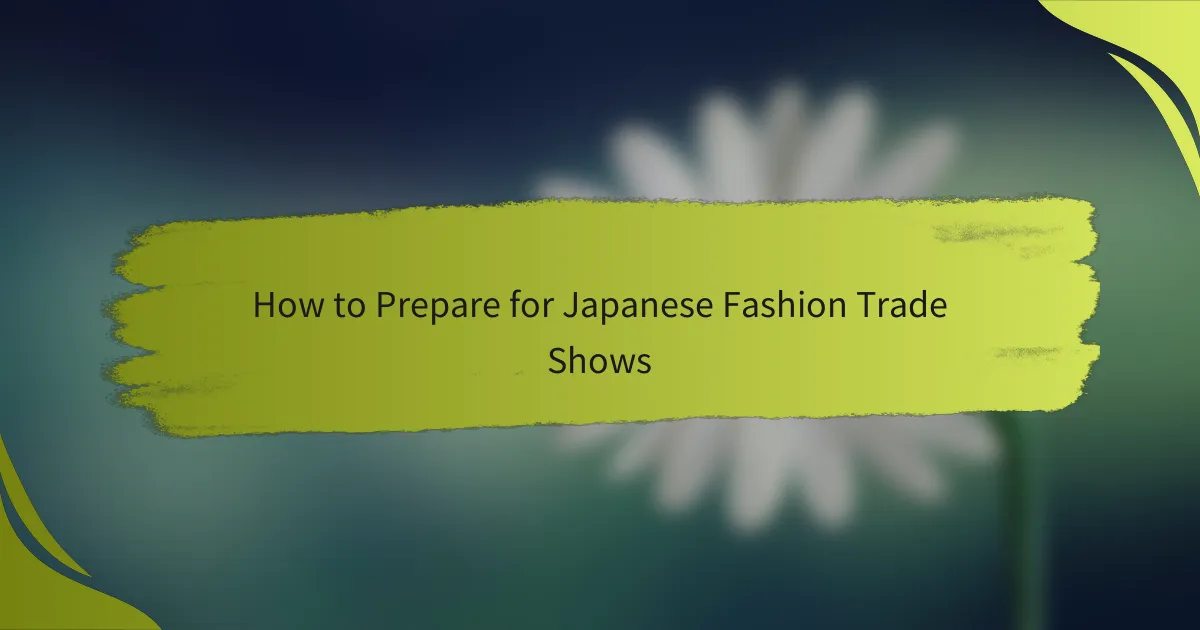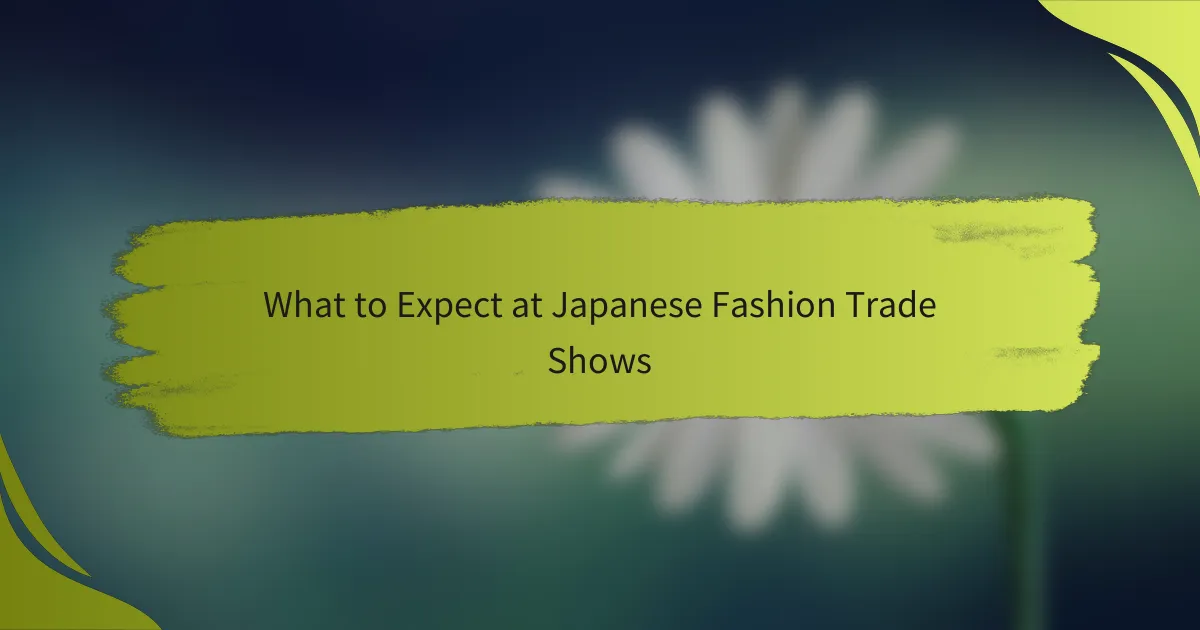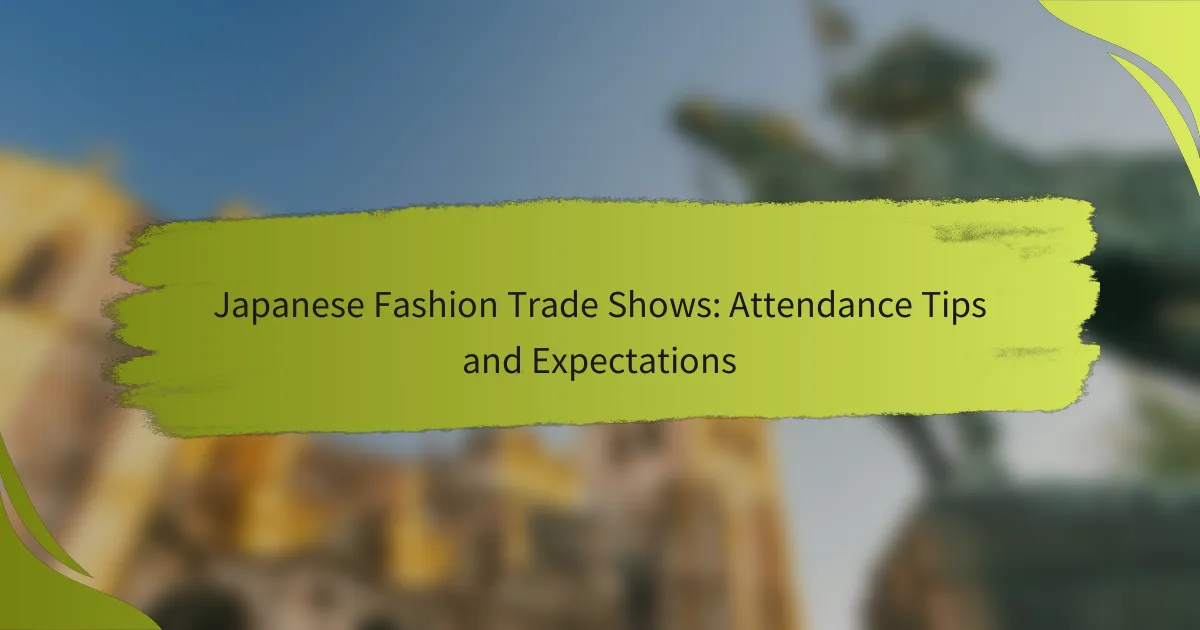日本のファッショントレードショーに参加する際は、事前の計画と戦略的な行動が重要です。業界の専門家と交流し、最新のスタイルを発見し、市場についての理解を深めるための教育セッションに参加することが期待できます。

How to Prepare for Japanese Fashion Trade Shows
Preparing for Japanese fashion trade shows involves thorough planning and strategic actions to maximize your experience. Focus on understanding the brands, logistics, and necessary materials to ensure a successful visit.
Research participating brands
Identifying the brands that will be present at the trade show is crucial. Look for a list of exhibitors on the event’s official website or promotional materials. This will help you prioritize which brands align with your interests and business goals.
Consider reaching out to brands in advance to schedule meetings or inquire about their latest collections. This proactive approach can lead to valuable networking opportunities and potential collaborations.
Plan your travel itinerary
Creating a well-structured travel itinerary is essential for a smooth experience. Book your flights and accommodations early, considering proximity to the venue to minimize travel time. Aim to arrive a day or two before the event to acclimate and prepare.
Include time for local transportation, meals, and rest in your itinerary. Familiarizing yourself with public transport options in Japan can save time and reduce stress during your stay.
Register in advance
Advance registration for the trade show is often required and can save you time on the day of the event. Check the registration deadlines and ensure you complete the process online to avoid long queues.
Some trade shows offer early bird discounts or exclusive access to certain events for pre-registered attendees. Take advantage of these benefits to enhance your experience.
Understand the venue layout
Familiarizing yourself with the venue layout can significantly enhance your efficiency during the trade show. Obtain a map of the venue, which is typically available on the event’s website or at the entrance.
Identify key areas such as registration, exhibition halls, and networking zones. This knowledge will help you navigate the space effectively and ensure you don’t miss important exhibits or meetings.
Prepare marketing materials
Having well-prepared marketing materials is essential for making a strong impression. Create business cards, brochures, or digital presentations that clearly convey your brand’s message and offerings.
Consider tailoring your materials to the Japanese market, incorporating relevant cultural elements and language. This can enhance your engagement with local brands and attendees, making your outreach more effective.

What to Expect at Japanese Fashion Trade Shows
Japanese fashion trade shows offer a unique blend of networking, trend spotting, and product showcasing. Attendees can expect to engage with industry professionals, discover the latest styles, and participate in educational sessions that enhance their understanding of the market.
Networking opportunities
Networking is a key component of Japanese fashion trade shows, providing attendees with the chance to connect with designers, retailers, and manufacturers. Building relationships can lead to collaborations and business opportunities, so it’s essential to come prepared with business cards and a clear pitch.
Consider attending networking events or mixers that are often scheduled during the show. These informal settings allow for more relaxed conversations and can help break the ice with potential partners.
Latest fashion trends
Trade shows are excellent venues for spotting emerging fashion trends. Attendees can observe the latest collections from various designers, which often reflect current consumer preferences and cultural influences. Pay attention to color palettes, materials, and styles that dominate the displays.
To maximize your trend-spotting experience, take notes and photos of standout pieces. This documentation can serve as a valuable reference when developing your own collections or making purchasing decisions.
Product showcases
Product showcases at Japanese fashion trade shows feature a wide range of items, from clothing to accessories. Exhibitors often highlight their best products, allowing attendees to see and feel the quality firsthand. This is a crucial opportunity to evaluate potential purchases or partnerships.
When visiting showcases, engage with the exhibitors to gain insights into their design process and target market. This information can be beneficial when considering how their products fit into your own business strategy.
Workshops and seminars
Many trade shows include workshops and seminars that cover various topics relevant to the fashion industry. These sessions often feature industry experts who share valuable insights on market trends, sustainability, and innovative design techniques. Attending these can enhance your knowledge and skills.
Check the schedule in advance and prioritize sessions that align with your interests or business needs. Participating actively by asking questions can also help you make the most of these learning opportunities.

What are the Key Japanese Fashion Trade Shows?
Japanese fashion trade shows are essential events for industry professionals to showcase their latest collections, network, and discover trends. Key shows include Tokyo Fashion Week, JFW Japan Fashion Week, Osaka Fashion Week, and the Tokyo International Gift Show, each offering unique opportunities and experiences.
Tokyo Fashion Week
Tokyo Fashion Week is a premier event that highlights the latest trends from both established and emerging designers. It typically occurs twice a year, showcasing a wide range of styles from streetwear to high fashion. Attendees can expect runway shows, presentations, and networking opportunities with industry insiders.
To make the most of your experience, plan your schedule in advance, as popular shows may require early registration. Dress appropriately for the fashion-forward environment, and be prepared to engage with designers and brands.
JFW Japan Fashion Week
JFW Japan Fashion Week is another significant event that focuses on promoting Japanese fashion on a global scale. It features a variety of exhibitions, runway shows, and seminars aimed at connecting designers with international buyers. The event usually takes place in the spring and fall, aligning with the fashion calendar.
When attending, consider participating in workshops or panel discussions to gain insights into industry trends. Networking is crucial, so bring plenty of business cards and be open to making connections with other attendees.
Osaka Fashion Week
Osaka Fashion Week showcases local talent and aims to boost the fashion scene in the Kansai region. This event typically features a mix of runway shows, exhibitions, and pop-up shops, allowing designers to engage directly with consumers. It usually occurs in the spring and fall, similar to other major fashion weeks.
For attendees, exploring the local fashion culture is a must. Take time to visit nearby boutiques and cafes to experience the unique Osaka style. Engaging with local designers can provide valuable insights into regional trends and consumer preferences.
Tokyo International Gift Show
The Tokyo International Gift Show is a comprehensive event that includes fashion accessories, home goods, and lifestyle products. This trade show attracts a diverse range of exhibitors and buyers, making it an excellent opportunity for networking and discovering new products. It is held biannually, typically in February and September.
To navigate the show effectively, prioritize the exhibitors you wish to meet and create a plan for your visit. Be prepared to discuss potential collaborations and partnerships, as many brands are looking to expand their reach through strategic alliances.

How to Maximize Your Attendance Experience
To maximize your attendance experience at Japanese fashion trade shows, focus on preparation and engagement. Setting clear goals, actively engaging with exhibitors, and attending relevant sessions will enhance your overall experience and help you achieve your objectives.
Set clear goals
Establishing clear goals before attending a trade show is crucial for a productive experience. Identify what you want to achieve, whether it’s networking, discovering new trends, or sourcing products. Having specific objectives will guide your actions and help you prioritize your time effectively.
Consider creating a checklist of your goals. For example, aim to connect with a certain number of exhibitors or attend specific sessions that align with your interests. This focused approach will keep you on track and ensure you make the most of your time at the event.
Engage with exhibitors
Engaging with exhibitors is essential for gaining insights and building relationships in the fashion industry. Approach booths with a clear introduction and express your interest in their products or services. This interaction can lead to valuable connections and potential collaborations.
Prepare questions in advance to facilitate meaningful conversations. Ask about their latest collections, sustainability practices, or market trends. Taking notes during discussions can help you remember key points and follow up later, enhancing your networking efforts.
Attend relevant sessions
Attending relevant sessions at trade shows can significantly enhance your knowledge and understanding of the fashion industry. Look for workshops, panel discussions, or presentations that align with your goals. These sessions often feature industry experts who share valuable insights and trends.
Plan your schedule in advance to ensure you don’t miss out on key sessions. Consider attending a mix of topics, such as emerging trends and marketing strategies, to broaden your perspective. Engaging in Q&A sessions can also provide opportunities to clarify your understanding and connect with speakers.

What Are the Costs Involved in Attending?
Attending Japanese fashion trade shows involves several costs, including registration fees, travel, and accommodation expenses. Understanding these costs can help you budget effectively and maximize your experience at the event.
Registration fees
Registration fees for Japanese fashion trade shows can vary widely depending on the event and its scale. Typically, these fees range from a few thousand yen to tens of thousands of yen. Early registration often comes with discounts, so it’s advisable to register as soon as possible.
Some trade shows may also charge additional fees for workshops or special events. Be sure to check the event’s official website for detailed pricing and any potential package deals that may include multiple services.
Travel and accommodation
Travel and accommodation costs will depend on your location and the duration of your stay. Flights to Japan can range from low hundreds to over a thousand USD, depending on your departure city and the time of booking. Consider using flight comparison websites to find the best deals.
For accommodation, options vary from budget hostels to luxury hotels. Average nightly rates in major cities like Tokyo can range from 5,000 yen for budget options to over 20,000 yen for upscale hotels. Booking in advance can help secure better rates and availability.
